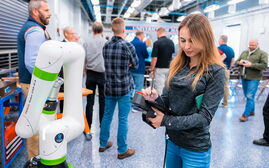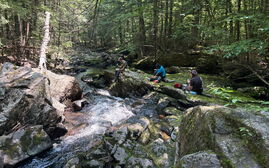Mills signs 10-year moratorium on new offshore wind projects in state waters
 Courtesy / State of Maine
Seen here is an area of interest, in federal waters off the southern Maine coast, for placing a research wind array. The blue dot at right represents the size of the array. Certain swaths, such as the Department of Defense wind exclusion area, won’t be included in the considerations.
Courtesy / State of Maine
Seen here is an area of interest, in federal waters off the southern Maine coast, for placing a research wind array. The blue dot at right represents the size of the array. Certain swaths, such as the Department of Defense wind exclusion area, won’t be included in the considerations.
A new law will prohibit construction of offshore wind-power sites in Maine waters, as part of a plan to push the electricity generators farther out to sea into federally controlled areas.
Gov. Janet Mills this week signed into law LD 1619, in response to concerns from Maine fishermen about the potential impact of offshore wind projects on their industry, according to a news release.
Up to 75% of Maine’s commercial lobster harvesting occurs in state waters.
The legislation was sponsored by Sen. Mark Lawrence, D-York, Senate Chair of the Legislature’s Energy, Utilities and Technology Committee.
“This legislation seeks to balance Maine’s existing heritage industry work with innovation in the clean energy sector,” said Heather Johnson, commissioner of the Department of Economic and Community Development.
The moratorium leaves in place a project that’s already underway in state waters near Monhegan Island. That project, by the University of Maine and New England Aqua Ventus, is the development of a single-turbine demonstration site for floating wind technology.
Federal waters
The new law comes after Mills last month signed into law another bill, LD 336, which advances the state’s creation of the nation’s first research area for a floating offshore wind array in federal waters in the Gulf of Maine.
In the coming weeks, the Governor’s Energy Office plans to move that plan forward. The administration is proposing the research array of up to 12 turbines, to be mounted on floating platforms developed by the University of Maine, over an area of up to 16 square miles. The project is financed by a public-private partnership with New England Aqua Ventus, a joint venture of two global offshore wind companies, Diamond RWE and Mitsubishi. The proposed array is a fraction of the size of most commercial-scale projects.
“Offshore wind is an enormous opportunity for Maine’s energy and marine businesses to further strengthen the state’s economy,” said Dana Connors, president of the Maine State Chamber of Commerce. “Maine’s companies are well positioned to seize this opportunity and build expertise for the 21st century.”
Under LD 336, the Maine Public Utilities Commission is authorized to negotiate a contract with a transmission and distribution utility to purchase up to 144 megawatts of energy from the proposed array.
Research from the array is expected to inform development of floating offshore wind throughout the United States and leverage Maine’s ability to take advantage of its home-grown energy resources in the Gulf of Maine, which has enough clean energy potential to meet all of Maine’s electricity needs by 2050.
“Maine has the opportunity to lead the way with floating offshore wind technology and create a whole new local economy,” said Grant Provost, business agent with Ironworkers Local 7. “We applaud the governor’s continued support of offshore wind while protecting state waters for commercial and recreational use. The Ironworkers look forward to the hundreds, if not thousands, of good-paying, family-sustaining union careers accompanying this one-of-a-kind opportunity.”
High wind speeds
The Governor’s Energy Office and Department of Marine Resources have been holding public meetings with fishing, wildlife and environmental organizations aimed at finding an optimal site for the floating array with minimal impacts to other stakeholders.
The Gulf of Maine is home to some of the highest sustained wind speeds in the world, which gives offshore wind the potential to be a source of renewable energy and reduce Maine’s nation-leading dependence on heating oil. Maine residents spend more than $4 billion annually to import to fossil fuels.
It’s also projected that a Gulf of Maine offshore wind industry could create good-paying trades and technology jobs, by advancing the University of Maine’s innovative floating offshore wind technology, forging public-private partnerships for research, development and workforce training, and investing in Maine’s deep-water ports.
Offshore wind is estimated to become a $70 billion industry in the U.S. by 2030, and a $1 trillion global industry by 2040. It’s projected to have the potential to create thousands of new, good-paying jobs in clean energy, marine industries and skilled trades.
“Offshore wind is an international industry,” said Wade Merritt, president of Maine International Trade Center and director of International Trade for Maine Department of Economic and Community Development.
“No matter where individual projects are physically located, our innovation and manufacturing assets, as well as proximity to market, makes Maine an important partner for developers with global supply chains. From directly producing components and providing a strategic location for access to projects along the U.S. East Coast, Maine companies in this sector are well positioned to benefit from the significant growth expected.”
Research consortium
In addition to prohibiting wind construction in state waters, LD 1619 tasks the state with establishing a research consortium comprised of experts in offshore wind, Maine’s fishing industry and the marine environment, to oversee and coordinate the array’s research efforts.
The developments come at a time when national and regional activities in offshore wind are increasing. On March 29, the federal government announced a target of 30 gigawatts of electricity from offshore wind by 2030 and its intention to open ocean leasing for commercial-scale offshore wind projects on the East Coast. On March 26, Massachusetts enacted a law committing to the purchase of 2,400 megawatts of offshore wind energy by 2027.
The Governor’s Energy Office has joined the Business Network for Offshore Wind, a national nonprofit dedicated to growing the offshore wind industry and launched a Maine-specific supply chain network to connect Maine companies with offshore wind opportunities.
Further steps
Further steps to advance offshore wind in Maine begin this month. In coming days, the Governor’s Energy Office will also identify a preferred site for the research array, in advance of submitting a formal application for the area to the federal Bureau of Ocean Energy Management later this summer.
Since December, the Governor’s Energy Office has held a series of public meetings to solicit information about a potential array site, which is generally targeted for 20-40 miles from the southern Maine coast, in an area to allow for connection to the mainland electrical grid at Wyman Station in Yarmouth or Maine Yankee in Wiscasset.
The Governor’s Energy Office, in consultation with other agencies, is now reviewing data collected to inform the siting of the array, with an emphasis on identifying a location with the least potential conflicts with fishing, wildlife and other ocean activity.
Virtual public meetings are scheduled on July 13 and July 14 about the siting and to start the public process to develop an Offshore Wind Roadmap for Maine, a strategic plan for developing an offshore wind industry in the state. Click here for more information.
Work on the roadmap will be supported by expert working groups on energy markets, ports, workforce, marine transportation, supply chains, fisheries, and wildlife as it relates to offshore wind. The roadmap is expected to be completed by the end of 2022.
The full regulatory review process with BOEM is expected to take several years.
Mainebiz web partners
I applaud the establishment of this research area in the Gulf of Maine for floating offshore wind. However, there are numerous floating wind turbine technologies under development; many already developed and successfully deployed in other locations. Maine's offshore wind potential should not be held hostage by one in-state research project that may or may not prove commercially viable. That research area can be home to several wind farms without any serious impact to the lobster zones involved.














1 Comments